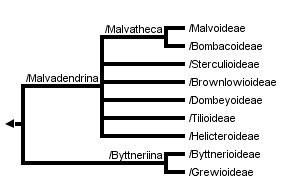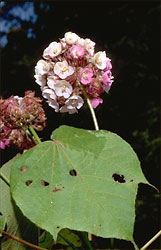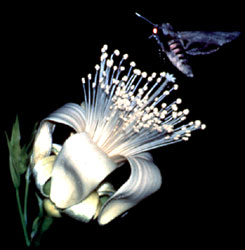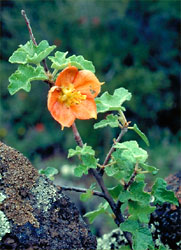Core Malvales
Stacey D. Smith and David A. Baum


This tree diagram shows the relationships between several groups of organisms.
The root of the current tree connects the organisms featured in this tree to their containing group and the rest of the Tree of Life. The basal branching point in the tree represents the ancestor of the other groups in the tree. This ancestor diversified over time into several descendent subgroups, which are represented as internal nodes and terminal taxa to the right.

You can click on the root to travel down the Tree of Life all the way to the root of all Life, and you can click on the names of descendent subgroups to travel up the Tree of Life all the way to individual species.
For more information on ToL tree formatting, please see Interpreting the Tree or Classification. To learn more about phylogenetic trees, please visit our Phylogenetic Biology pages.
close boxPhylogeny of core Malvales based on Alverson et al. (1999). The rankless names for each of the clades are indicated by a forward slash.
Introduction
The core Malvales contains taxa traditionally divided among four families, Bombacaceae, Malvaceae, Sterculiaceae and Tiliaceae. Molecular phylogenetic analyses (Alverson et al. 1998; Bayer et al. 1999) showed that these families do not form natural (monophyletic) groups; thus a new classification of the core Malvales has been proposed with nine named clades (as shown above). In total, the core Malvales comprises approximately 2300 species in 204 genera (Judd et al. 1999). This group contains several economically important taxa, such as Theobroma cacao (the source of cocoa), Gossypium (cotton), Durio zibethinus (durians, a fruit) and many ornamental plants, such as Hibiscus, Althaea (hollyhocks) and Malva (mallows).
Characteristics
The core Malvales share the same suite of characters commonly found in other families in the expanded Malvales, e.g., leaves with palmate venation (often three principal veins arising from the base of the leaf blade), mucilage canals within the tissues (think of the slime in Okra), stellate (star-shaped) hairs on the vegetative parts of the plant and stipules (leaf-like structures at the base of the leaf stalk). In addition, members of the core Malvales have nectaries composed of glandular hairs, usually on the calyx, and seeds with cyclopropenyl fatty acids.
Discussion of Phylogenetic Relationships
Molecular data from the chloroplast genes atpB and rbcL and particularly ndhF have allowed us to identify major lineages in the core Malvales (Alverson et al. 1999; Bayer et al. 1999), and in some areas, the relationships among these lineages. /Malvoideae and /Bombacoideae form a well-supported clade, termed /Malvatheca (Baum et al. 1998) in reference to their unusual monothecate stamens. The clade formed by /Malvatheca + /Sterculioideae + /Brownlowioideae + /Dombeyoideae + /Tilioideae + /Helicteroideae was named /Malvadendrina (Baum et al. 1998), although no morphological characters have been identified which unite this group. The /Byttneriina clade, /Byttneroideae + /Grewioideae (Baum et al. 1998) is strongly supported as the sister group to the /Malvadendrina although it too lacks apparent morphological synapomorphies.
Interesting Malvalean species
Althaea officinalis, commonly known as the marshmallow, is a perennial herb often found in marshy areas of Europe and northeastern North America. Its thick roots contain about 20% mucilage, the jelly-like substance used to make the original marshmallows. In the nineteenth century, the French began mixing the mucilage from Althaea roots with sugar and egg whites to make a foamy meringue that hardened to form a medicinal candy for soothing sore throats. Although the modern marshmallow gets its texture from gelatin and not Althaea's mucilage, powdered Althaea root is still commonly used in teas to treat colds and sore throats.
References
Alverson, W. S., K. G. Karol, D. A. Baum, M. W. Chase, S. M. Swensen, R. McCourt, and K. J. Sytsma. 1998. Circumscription of the Malvales and relationships to other Rosidae: Evidence from rbcL sequence data. American Journal of Botany 85:876-887.
Baum, D. A. 1995. The comparative pollination and floral biology of baobabs (Adansonia- Bombacaceae). Annals of the Missouri Botanical Garden 82(2):322-348.
Baum, D. A., W. A. Alverson, and R. Nyffeler. 1998. A Durian by any other name: Taxonomy and nomenclature of the core Malvales. Harvard Papers in Botany 3:315-330.
Bayer, C., M. F. Fay, A. Y. De Bruijn, V. Savolainen, C. M. Morton, K. Kubitzki, W. S. Alverson, and M. W. Chase. 1999. Support for an expanded family concept of Malvaceae with a recircumscribed order Malvales: a combined analysis of plastid atpB and rbcL DNA sequences. Botanical Journal of the Linnean Society 129:267-303.
Judd, W. S., C. S. Campbell, E. A. Kellogg, and P. F. Stevens. 1999. Plant Systematics: A Phylogenetic Approach. Sinauer, Sunderland, Massachusetts.
Information on the Internet
Malvaceae InfoTitle Illustrations

| Scientific Name | Dombeya |
|---|---|
| Location | Ranomafana National Park (Madagascar) |
| Comments | /Dombeyoideae |
| Creator | Photograph by Gerald and Buff Corsi |
| Specimen Condition | Live Specimen |
| Source Collection | CalPhotos |
| Copyright |
© 2000 California Academy of Sciences

|
| Scientific Name | Fremontodendron californicum ssp. decumbens |
|---|---|
| Location | Pine Hill (El Dorado County, California, USA) |
| Comments | Pine Hill Fremontia (/Malvoideae) |
| Creator | Photograph by G. F. Hrusa |
| Source Collection | CalPhotos |
| Copyright | © 2001 |
About This Page

Duke University, Durham, North Carolina, USA

University of Wisconsin, Madison, Wisconsin, USA
Correspondence regarding this page should be directed to Stacey D. Smith at
Page copyright © 2003 and
 Page: Tree of Life
Core Malvales.
Authored by
Stacey D. Smith and David A. Baum.
The TEXT of this page is licensed under the
Creative Commons Attribution License - Version 3.0. Note that images and other media
featured on this page are each governed by their own license, and they may or may not be available
for reuse. Click on an image or a media link to access the media data window, which provides the
relevant licensing information. For the general terms and conditions of ToL material reuse and
redistribution, please see the Tree of Life Copyright
Policies.
Page: Tree of Life
Core Malvales.
Authored by
Stacey D. Smith and David A. Baum.
The TEXT of this page is licensed under the
Creative Commons Attribution License - Version 3.0. Note that images and other media
featured on this page are each governed by their own license, and they may or may not be available
for reuse. Click on an image or a media link to access the media data window, which provides the
relevant licensing information. For the general terms and conditions of ToL material reuse and
redistribution, please see the Tree of Life Copyright
Policies.
- First online 25 March 2003
Citing this page:
Smith, Stacey D. and David A. Baum. 2003. Core Malvales. Version 25 March 2003 (under construction). http://tolweb.org/Core_Malvales/21172/2003.03.25 in The Tree of Life Web Project, http://tolweb.org/











 Go to quick links
Go to quick search
Go to navigation for this section of the ToL site
Go to detailed links for the ToL site
Go to quick links
Go to quick search
Go to navigation for this section of the ToL site
Go to detailed links for the ToL site